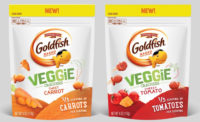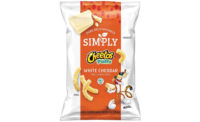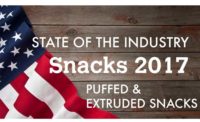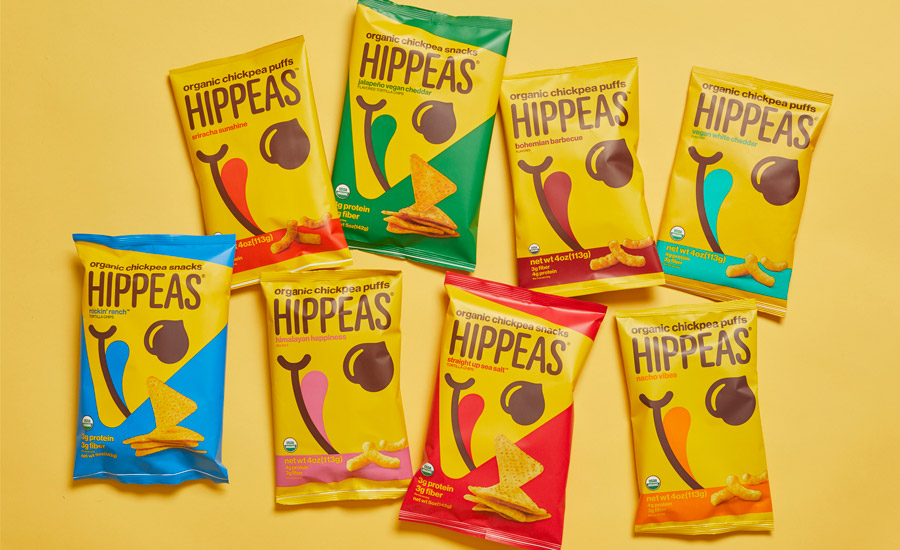State of the Industry 2020: Puffed and extruded snacks grow through innovation
Consumers embrace snack flavor and format diversity.






















The puffed and extruded snacks category has grown-up, and the market is seeing some diverse company. While classic products like Cheetos and Funyuns still reign supreme, responsible for billions in sales annually, a wider swath of consumers is now searching for healthier alternatives, as well as highly interesting flavor combinations.
Overview | Chips | Puffed/Extruded Snacks | Popcorn | Snack Mixes & Nuts | Tortilla Chips | Pretzels | Frozen Snacks | Crackers
Market data
Puffed and extruded snacks are one of the most diverse and active segments of the snack industry, with sales approaching $10 billion annually.
According to data from IRI, Chicago for the 52 ending May 17, 2020, the “other salted snacks (no nuts)” segment of salty snacks brought in $5.0 billion in sales, with an increase of 6.7 percent. Frito-Lay leads every core segment of puffed and extruded snacks, and the company’s sales in this segment grew 8.6 percent to $3.3 billion. Its Funyuns brand brought in $442.2 million, an 8.5 percent sales increase. The Chesters brand added $330.1 million, up 4.3 percent. SunChips contributed another $313.6 million, up 9.3 for the year. Also, the Hain Celestial Group brand Sensible Portions Garden Veggie Straws had a banner year, up 28.5 percent to $123.5 million.
Cheese snacks category was up 13.7 percent, with total sales of $2.9 billion. Frito-Lay commands this segment, with a collective total of $2.3 billion in sales and a 10.1 percent increase. Its iconic Cheetos brand is responsible for the lion’s share of that total, with $2.0 billion in sales, up 9.4 percent. Simply Cheetos added $116.7 million, up 20.8 percent. The portable, individual-sized Cheetos Flavor Shots brand was responsible for $25.9 million in sales. Kellogg Co. brand Cheez-It Snap’d, launched in 2019, had a fantastic year, with $110.3 million in sales.
The corn snacks segment brought in $1.3 billion in sales, with an increase of 7.3 percent. Frito-Lay commands nearly 80 percent market share for this segment, led by its Fritos brand, which was up 1.6 percent to $527.3 million. Its Fritos Scoops brand saw a larger increase of 14.2 percent to $270.9 million, and Fritos Flavor Twists grew 8.2 percent to $165.0 million. BFY Brands had a great year for its PopCorners products, up 53.3 percent to $60.2 million.
Sales of pork rinds were up 5.9 percent overall, with total sales of $596.9 million. Frito-Lay took home $133.6 million of that share, but experienced a loss of 5.6 percent in sales. Mac’s Snacks showed strong growth, $100.0 million in sales and an increase of 26.6 percent. Private label pork rinds rose a highly notable 56.8 percent, with $51.4 million in sales. The Rudolph Foods brand Southern Recipe had an increase of 34.9 percent in sales to $11.8 million in revenue.
Looking back
Puffed and extruded snacks routinely win on both ends of the nutritional spectrum. Healthy extruded snacks are still a major trend, and indulgent snacks are also on the rise, says Julie Prost, pilot plant manager and process engineer, Clextral USA, Tampa, FL. “Consumers are reading nutritional statements on snacks and looking for free-from claims, such as grain-free, gluten-free, GMO-free, animal-free (vegan), and allergen-free. They also want added protein, fiber, and nutrients, which add challenges in ingredient selection.”
Snacks must offer more than good taste—they need interesting visual appeal and clean ingredient statements, to be ethically and sustainably processed, and to have a compelling product story, says Prost. “This story could be about the ingredients, how the snacks are made, or interesting nutritional aspects.”
Samy Kobrosly, chief snack bagger/co-founder, SNACKLINS, Rockville, MD, has found that consumers have a desire for more information about the vegan “pork” rinds the company offers. They’re yearning to know more about their food, including that food’s story, including origins, processing, etc., he says.
Brad Schwan, senior director, marketing, ADM, Chicago, believes that consumers today think differently about snacking. “Snacks serve a variety of consumer needs—from convenient energy and meals-on-the-go to indulgences. Depending on the need, consumers crave different types of snacks, driving a variety of trends across the category,” he says.
Snacking to fuel the body with sustained energy for the day is inspiring the growth of better-for-you snacks featuring nutrient-dense ingredients like dietary fiber, whole and ancient grains, and plant-based proteins, says Schwan. “These simple and wholesome ingredients align well with consumer desires for shorter, more recognizable ingredient lists.”
Products featuring preferred flavors and pleasing textures are more likely to win over modern consumers who have high expectations for the complete sensory experience a snack can deliver, says Schwan. “Spicy flavors continue to be popular within the snacking category, with increased use of globally inspired flavors expected to continue to grow and bring excitement to the category. We anticipate feelings of uncertainty linked to the pandemic might inspire consumers to seek out comfort through food, particularly snacks featuring familiar, nostalgic comfort food flavors such as bacon or s’mores.”
Nick Desai, CEO and founder, PeaTos, Los Angeles, says that some brands are shifting away using the corn base that consumers grew up on in favor of alternative, nutrient-dense product substrates like peas, lentils, and chickpeas. “I’ve also noticed a much higher demand by consumers for stronger taste profiles that rival the traditional salty snacks consumers know. People still want snacks to taste comforting, but without the use of artificial ingredients.”
PeaTos Crunchy Rings were launched in late 2019, and they’ve been a huge hit, says Desai. “The Crunchy Rings are our take on Frito-Lay’s Funyuns, and offer a better-for-you experience with the same taste, texture and crunch consumers love. They’re available in Classic Onion and Fiery. We’re always testing new flavors and products, and will have some exciting new options in the near future.”
HIPPEAS, made with chickpeas, also fits the description of an “alternative” snack. “Plant-based products and better-for-you snacks are making a meaningful impact in the category. Consumers want to eat better and live healthier,” says Livio Bisterzo, founder and chairman, HIPPEAS, Plainview, NY. “Whether that means swapping out a traditional snack for something with protein or eating more plant-forward meals, they’re making changes to feel better about what they are putting in their bodies. We’ve seen success with HIPPEAS because of our key chickpea ingredient that enables us to make a traditional, tasty snack, but with quality ingredients.”
Deb Holt, CMO, REAL FOOD FROM THE GROUND UP, Fairfield, NJ, says they continue to see the acceptance and growth of healthier and plant-based options in the puffed and extruded snack category. “We have found consumers believe that healthier snacking and happiness must go hand-in-hand for a balanced lifestyle. They want more out of life, have real cravings, and are not into denial or sacrifices.”
REAL FOOD FROM THE GROUND UP Cauliflower Stalks have added excitement and incremental revenue growth to the set and are made with real cauliflower, Holt adds. The brand also introduced two Butternut Squash Stalk offerings this spring—one savory (Sea Salt) and one sweet (Cinnamon). “This is the first product line in the portfolio to introduce a sweet taste profile, bringing a whole new ‘indulgent’ twist on puffed snacks,” she explains. “Made with ingredients you can say, including Real Butternut Squash and other plant-based ingredients, these lightly fried Stalks are truly sweet-tooth satisfying.” The snacks are gluten-free, vegan, and Non-GMO Project verified.”
Consumers are searching for puffed and extruded snacks made with diverse ingredients. “For nearly a decade, consumer preferences for new products have veered toward better-for-you, health-and-wellness-focused, clean-label-centric offerings,” says Mel Festejo, COO, American Key Food Products, Closter, NJ. “The enormous snack industry, including the puffed/extruded category, rode on this trend. More nutritious ingredients, as well as those that met with the criteria for specialty dietary needs—e.g., gluten-free, grain-free/Paleo—entered the portfolio for options by formulators.”
The market saw the introduction of puffed snacks made with caseinate and whey protein a few years ago, says Festejo. “These ingredients enabled higher-protein, nutritious products to be the guilt-free snacking choices for consumers. Snacks using less-traditional flours, such as those from legumes, made their way into the market, as well. Puffed/extruded snacks based on chickpeas and lentils were among the touted innovations. With the increasing popularity and acceptance of analogue meat products using plant-based proteins in the last two years, the halo of better-for-you snacks grew further.”
Meanwhile, the consumer base for specialty-diet products continues to grow, Festejo notes. The demand for grain-free and Paleo-friendly snacking products have been particularly on the rise. “This, coupled with the growing preference for the better-for-you snacks, have brought to growing prominence a new breed of ingredients that fit the criteria demanded by consumers. High-protein and/or high-fiber, functional ingredients, or those that fall within the boundaries of autoimmune protocol (AIP)/Paleo diets, are becoming more sought-after,” he says. Thus, flour from cassava and almonds are now in more snack products, either as the central ingredients or complementary flours.
On the equipment side, the corn curl category is growing and adding considerable capacity, says Don Giles, director of sales, processing systems, Heat and Control, Hayward, CA. “The system capacity is generally getting larger—several thousand pounds per hour is the new norm,” he notes.
Looking forward
Schwan says that today’s consumers crave snacks that satisfy their expectations for flavor and texture without skimping on potential wellness and nutritional benefits, and it’s challenging formulators to experiment with emerging ingredients, texture-enhancing inclusions, and exotic flavor profiles. “Recently, puffed snacks have been growing at about twice the rate of the broader snacks category. We expect this to continue and be further fueled by the utilization of emerging bases like bean and pea and the creation of great-tasting, higher-protein puffed offerings.”
In addition to taste and texture, consumers are also seeking snacks with additional functional benefits that help address specific aspects of health, including products that support healthy immune function, Schwan adds. “Rising interest in gut and microbiome health holds huge potential for the snack food space in the year ahead. Research shows that the microbiome is vital to supporting overall wellness and the immune system. Snacks that are formulated with ingredients that promote a healthy microbiome can help consumers meet this need.” He notes that solutions such as prebiotic fibers and ADM’s new heat-tolerant BPL1 postbiotic ingredients—which contain beneficial bacteria strains that are no longer living—can benefit the microbiome and can add positive nutritional benefits to snack foods.
“One of the main challenges formulators face is striking a balance between nutrition, sensory experience, and cost,” says Schwan. “Clearly communicating value to the consumer is key to a successful snack product. ADM’s OutsideVoice proprietary research shows that 30 percent of consumers are willing to pay a premium for products made with highly nutritional ingredients, such as fiber, protein, whole grains, and vitamins. Emphasizing the functional benefits of these ingredients on the package is a great way to demonstrate value.”
Despite consumers clamoring for healthier ingredients, convenience is still a factor. The trend of snacking for energy is growing as consumers look to convenience foods to fuel their busy days, Schwan expands. “Consumers associate plant-based proteins with healthfulness, and there are many options available from whole grains, beans, and pulses, to more-concentrated protein ingredients made from pea or soy. These can be used in combination with ingredients like flax and chia seeds or vegetable and fruit powders to create a unique snacking experience with the enhanced nutritional profile that consumers demand.”
Prost says that new ingredients and ingredient combinations can yield protein-rich formulations, including grains (soy, wheat, quinoa), pulses (yellow pea, chickpea, green pea, lentil, fava bean), and animal-sourced ingredients (egg white, caseinates, whey protein). “Fiber-enhanced snacks use more whole-grain flours and refined fiber. Vegetable-based inclusions are also becoming popular.”
In production, the challenge is always to provide a snack with the appropriate texture (expansion ratio, density), the right appearance, and appealing taste. Twin-screw extrusion technology is perfectly adapted to produce high-quality products with these new ingredients, Prost explains. “Healthy ingredients can be seen as hurdles, because without the appropriate process adjustment and fine-tuning, they can lead to denser, rougher, bitter products. Clextral’s research and development in healthy snacks and work with ingredient suppliers testing and understanding different ingredient functionalities has proven highly valuable to snack processors looking to design and produce healthy snacks,” she says.
For existing snack producers, the good news is that product innovation does not usually require investment in completely new technology, Prost notes. “New products can be made on the existing twin-screw extruder by changing processing parameters and/or extruder set-up. This gives snack manufacturers great flexibility to adapt to new market demands without a large capital expenditure.”
To extend the versatility of its extruders, Clextral offers a variety of “clip-on” modules and ancillary equipment for further processing: cutters, formers, filling equipment for snack pillows, drying, toasting, and enrobing are all downstream processes that can be configured to create different snacks, says Prost.
Giles says that companies have tried to increase sales by creating snacks in novel shapes, such as balls, horns, and tubes. “New trends that may affect the puffed/extruded category are the addition of higher-protein/nutritional aspects of the product, which may be achieved with new ingredient formulations.”
Kobrosly says that as consumers are growing more educated. They expect the brands they support to become more transparent, whether that transparency extends to process or product.
Bisterzo sees functional foods as having true staying power. “According to a study released in March by Kerry, 65 percent of consumers seek functional benefits from their food and drink. Consumers want to enjoy their favorite foods, but with added nutritional benefits like protein, vitamins, and minerals. A number of brands in our category are turning to vegetable-based ingredients to make their snacks more nutritious,” he says.
Christian Quie, president/general manager, Mavericks Snacks, Santa Monica, CA, says that COVID-19 has no doubt changed the game, and its impact will continue for the foreseeable future, with the most prominent trend doubling-down on consumers’ focus on wellness and immunity benefits. “Better-for-you will become more and more mainstream, while traditional ‘gut fill’/taste-only brands will lose category share,” he predicts—and this extends to products for all ages. “Consumers will demand more and more ‘all family’ solutions, or more targeted solutions for their kids, for instance.”
During times of uncertainty, consumers seek comfort from mainstream snack brands they have known and loved—often putting healthier options and mindful snacking aside, says Holt. “As we see more consumers begin to shift their eating habits back toward a balanced lifestyle, they will seek even more out of life and their snacks. No longer willing to trade taste for health, we will see a demand for snacks that deliver on both indulgence and guilt-free snacking.”
Festejo says that the big challenge to snack companies in the coming year is how to differentiate and remain competitive in a category where there are numerous new entrants launching innovative products and capturing the attention of consumers. “Today’s consumers have the luxury of a multitude of snack products to choose from. This makes it increasingly difficult for items to immediately stand out.”
Nonetheless, snack companies can lean on using new flavors to spice up their product portfolios, as well as leveraging emerging ingredients or even putting to use hitherto untapped ones to enhance the value proposition for competitiveness, notes Festejo. “As the growth in the market for organic products keeps its momentum, the shift to greater use of organic ingredients will be an important consideration in the immediate future.”
Overview | Chips | Puffed/Extruded Snacks | Popcorn | Snack Mixes & Nuts | Tortilla Chips | Pretzels | Frozen Snacks | Crackers
Looking for a reprint of this article?
From high-res PDFs to custom plaques, order your copy today!

















